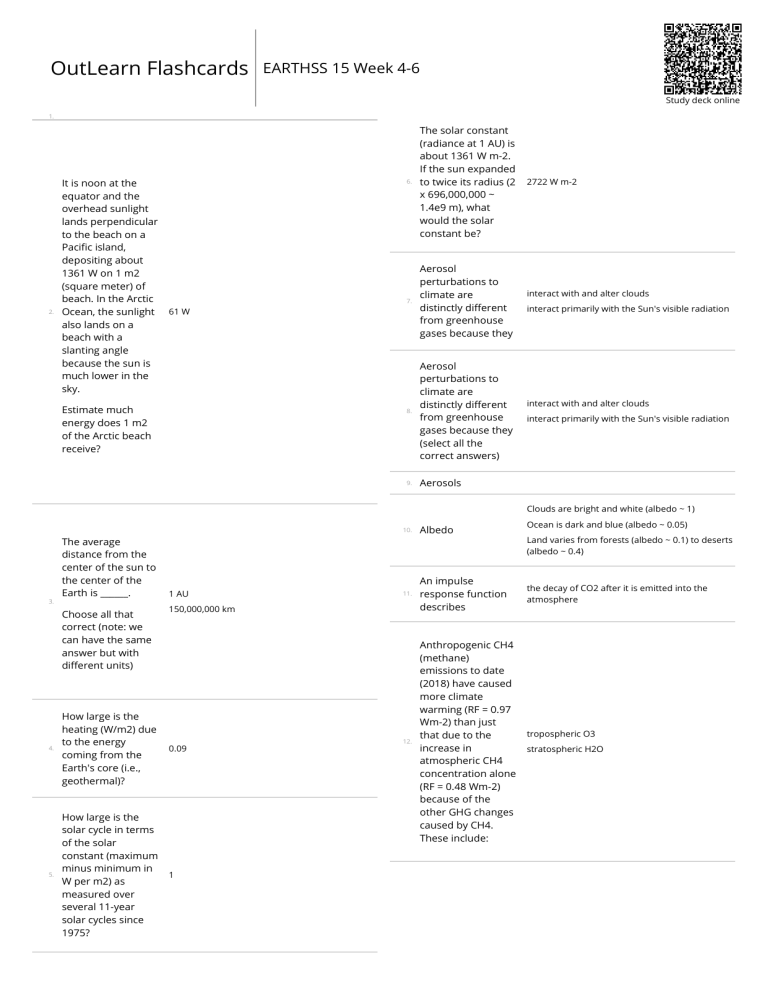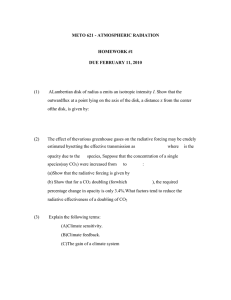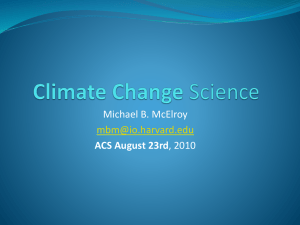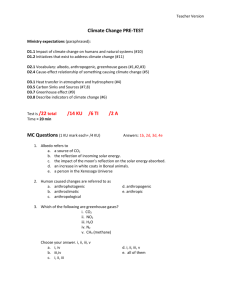
OutLearn Flashcards EARTHSS 15 Week 4-6 Study deck online 1. 2. It is noon at the equator and the overhead sunlight lands perpendicular to the beach on a Pacific island, depositing about 1361 W on 1 m2 (square meter) of beach. In the Arctic Ocean, the sunlight also lands on a beach with a slanting angle because the sun is much lower in the sky. 6. The solar constant (radiance at 1 AU) is about 1361 W m-2. If the sun expanded to twice its radius (2 x 696,000,000 ~ 1.4e9 m), what would the solar constant be? 7. Aerosol perturbations to climate are distinctly different from greenhouse gases because they 8. Aerosol perturbations to climate are distinctly different from greenhouse gases because they (select all the correct answers) 9. Aerosols 61 W Estimate much energy does 1 m2 of the Arctic beach receive? 2722 W m-2 interact with and alter clouds interact primarily with the Sun's visible radiation interact with and alter clouds interact primarily with the Sun's visible radiation Clouds are bright and white (albedo ~ 1) 10. 3. The average distance from the center of the sun to the center of the Earth is ______. Choose all that correct (note: we can have the same answer but with different units) 1 AU 11. An impulse response function describes 12. Anthropogenic CH4 (methane) emissions to date (2018) have caused more climate warming (RF = 0.97 Wm-2) than just that due to the increase in atmospheric CH4 concentration alone (RF = 0.48 Wm-2) because of the other GHG changes caused by CH4. These include: 150,000,000 km 4. How large is the heating (W/m2) due to the energy coming from the Earth's core (i.e., geothermal)? 0.09 5. How large is the solar cycle in terms of the solar constant (maximum minus minimum in W per m2) as measured over several 11-year solar cycles since 1975? 1 Albedo Ocean is dark and blue (albedo ~ 0.05) Land varies from forests (albedo ~ 0.1) to deserts (albedo ~ 0.4) the decay of CO2 after it is emitted into the atmosphere tropospheric O3 stratospheric H2O 13. 14. Arctic sea ice has a large seasonal cycle in areal extent ranging from about 8 10^6 km^2 in September to 15 x 10^6 km^2 in March. Climate change since 1970 has dramatically changed this seasonal cycle how? Climate feedback greatly reduced the September minimum to less than 5 x 10^6 km^2 Positive feedback - internal forcings that make the climate change greater than that caused by the initial RF Negative feedback - internal forcings that make the climate change less than that caused by the initial RF 15. Effective radiative forcing allows some parts of the climate system to adjust to an imposed perturbations, but not this one: ocean temperatures 16. Ein (Energy in from the Sun) (Solar Costant) x (1 - albedo) x (cross-sectional area of sunlit Earth) 17. For the period 1970-1990 which source of anthropogenic CO2 emissions is largest? 18. Greenhouse effect 19. 20. In terms of changing GHG concentrations in the atmosphere, which are the top 2 gases in terms of radiative forcing driving climate change? 21. In terms of major greenhouse gases (GHG) that alter climate, which 4 of these do we directly emit? fossil fuel use Gases (H2O, CO2, CH4, N2O, O3, and clouds) prevent earth from radiating like a blackbody. Greenhouse gases and clouds trap some of earth's thermal radiation in the atmosphere. Planets are not 100% efficient as blackbodies (stars). Temperature of planets must increase to emit the same amount of energy. Greenhouse gases like CO2 trap the outgoing thermal radiation from the surface that cools the Earth, and only allow that radiation to be emitted to space and cool the climate system from an atmospheric altitude of about 12 km in the IR regions (wavelength bands) where CO2 absorbs. Describe ALL the changes that occur in the climate system what happens after we increase CO2 in the atmosphere. Assume that a radiative balance (Ein = Eout) is reached. Select all the correct answers. 22. Looking at the big 3 greenhouse gases from year 0 to 2020, when did these gases clearly show signs of the Anthropocene? (pick best answer) 23. Major feedback loops that are positive and enhance global warming include: [Select all correct answers.] the increased radiation from the warmer surface balances the reduced radiation from the CO2 bands the Earth's radiation emitted in the CO2 bands (at a higher, colder altitude) decreases the total CO2 capacity of the atmosphere increases the climate system, including both atmosphere and surface, warms CO2, CH4 CFO3 CH4 CO2 N2O 1950 temperature - Arctic soils - CO2 emissions - RF loop atmospheric H2O - RF - temperature loop sea ice - albedo - temperature 24. 25. 26. Match these components of the Earth's energy budget with their approximate values (W per m2) average outgoing longwave radiation emitted by the Earth: 235 W/m^2 1360.6 W m^-2 Solar constant 36. Suppose our sun shrinks to yellow sub-dwarf star. The radius drops from 696,000,000 to 348,000,000 m (2x smaller while maintaining the same effective blackbody temperature of 5788 K). What would the new solar constant be? 340 W m-2 37. The Earth's climate has a large variation in climatic zones ranging from the tropics (hot, steamy) to the poles (cold, dry). What single, simple, physical phenomenon best explains these different climate zones? The angle of incident sunlight means more energy is absorbed in the tropics than at the poles. 38. The estimated change in solar energy over the 11-year solar cycle is what fraction of the GHG induced warming <5% 39. The text uses an n-layer radiative model to explain the atmospheric greenhouse effect that makes the surface temperature warmer that of a similar 'blackbody planet' without an atmosphere. What is wrong with this explanation? Select all the correct answers instantaneous incident sunlight at noon in the tropics: 1361 W/m^2 incident sunlight averaged over the Earth: 342 W/m^2 amount of sunlight reflected by the Earth (average): 107 W/m^2 Natural climate forcing Natural forcing of climate change is caused by volcanoes and solar variability. For the period 1850 to 2018, about what fraction of the total forcing is estimated to be natural 2% 27. Over the 21st century higher latitudes and continents warm more than the tropics and oceans under all the scenarios investigated by the IPCC. 28. Over the past 20 years, the increase in atmospheric N2O has been steady and smooth? True 29. Over the past 40 years, the increase in atmospheric CH4 has been nearly constant? False 30. Processes involving uptake of atmospheric CO2 by the upper ocean (mixed layer) occur on time scales of 1-10 years 31. Radiative forcing net change in the energy balance of the Earth system due to some imposed perturbation 32. Radiative forcing of climate change is an imposed change on the energy balance of the Earth 33. Sea Ice - Albedo Climate Feedback True Positive Climate Feedback 34. Select the correct title for this figure from IPCC 2013 Arctice Ice melts, lowers earth's albedo, increases sunlight absorbed, climate gets warmer and thus melts more ice Relative Sea Level Change 2081-2100 relative to 1986-2005 Solar Constant doesn't change as the earth revolves around the sun as it is defined based on the mean orbit of 1 AU 35. 40. The total Effective Radiative Forcing caused by human activities from 1750 to 2018 is about It is not physically based, since there is no way to relate the number of layers to the greenhouse gas amount. It fails to recognize that the atmosphere heats by convection. 2.5 W m-2 stratus 41. What are examples of the types of clouds (select all that are correct) altostratus deep cumulus towers shallow cumulus cirrus 51. convective anvils 42. What causes the large seasonal cycling of CO2 seen at Mauna Loa? (select all that are correct) Which of the following atmospheric constituents contribute to the greenhouse effect (i.e., warming the surface temperature above that of a black body) respiration What do you think would happen to the Earth's oceans if our sun's radius is reduced by a factor of 2 but the effective temperature remains the same at 5788 K? freeze at the surface What is the average albedo of the Earth? 0.3 Which of these human activities are significant sources of CH4? [Select all appropriate answers.] 53. Which part of the ocean has the largest reservoir of C (carbon)? 54. RCP2.6 Which statements below (more than one) best describe changes in precipitation for year 2100 under scenario RCP8.5? 55. 46. What is the CO2 abundance at Mauna Loa Observatory as of Dec 2020? 414 ppm Why do we calculate Radiative Forcing to estimate climate change? 47. What is the equation that best represents the simple climate model? E_in = E_out 48. What part of the climate system has the largest mass and takes centuries to heat up? the oceans 49. When did Chinese emission of CO2 first surpass USA emissions? 2007 50. When the atmosphere warms by 1°C, it can hold how much more H2O vapor? 7% 44. 45. What is the climate stabilization scenario used in IPCC 2013 N2O CO2 H2O clouds decay 52. 43. CH4 fossil fuels rice cultivation landfills biomass burning livestock intermediate and deep ocean dry regions become drier wet regions become wetter because radiative forcing is linearly related to global warming




![Ka-Kit Tung [], Dept. of Applied Mathematics, University of Washington, Seattle](http://s2.studylib.net/store/data/013086452_1-31792848fbed113d64636fabab789840-300x300.png)
